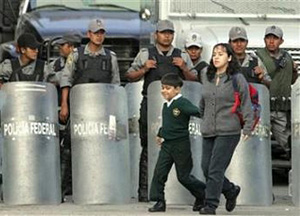 |
 |
 |
 Editorials | Issues | November 2006 Editorials | Issues | November 2006  
"Old Mexico" Raises Ugly Head in Oaxaca Crisis
 Frank Jack Daniel - Reuters Frank Jack Daniel - Reuters


| | A woman and her son walk past federal police officers in downtown Oaxaca city, November 9, 2006. (Daniel Aguilar/Reuters) |
Lauded in the United States for democratic gains and economic stability, Mexico has shaken off much of the baggage of one-party rule that ended when President Vicente Fox came to power in 2000.

But the Mexico of corruption, poverty and brutality, lingers just below the surface in large swathes of the country, ready to burst forth.

The poor southern state of Oaxaca has been gripped for six months by the kind of violent political crisis that many in Washington and Wall Street thought had ended when Mexicans voted the Institutional Revolutionary Party, or PRI, out of the presidency six years ago.

Fox's conservative government has been helpless to stop the conflict between a heavy-handed state governor and leftists, striking teachers and indigenous groups who are seeking to force him from office.

"What we have today is a mosaic of different grades of democracy," said political analyst Irma Mendez. "We have elements of both a modern Mexico and of the most authoritarian and traditional Mexico," she said.

At least a dozen people have been killed in the Oaxaca violence, mostly protesters shot by shadowy gunmen believed by human rights groups to be off-duty police loyal to PRI Gov. Ulises Ruiz.

Rival demonstrations along streets often barricaded by protesters are almost a daily occurrence in Oaxaca's pretty colonial capital, now daubed by graffiti against Ruiz.

Oaxaca borders Chiapas, where in 1994 leftist Zapatista rebels burst from the jungles in a brief but bloody uprising.

"This is the old Mexico, where those who govern have for a century used threats and beatings to decide what happens in the state," said trade union member Jose Antonio Rivera in Oaxaca.

THE HILLS ARE ALIVE

The mountainous state is known to tourists for Pacific surfer hangouts and pre-Hispanic ruins, but it has another, darker face.

The hills behind Oaxaca city's wide valley hide hundreds of villages where generations of corrupt governments have failed to improve grinding poverty, poor schooling and almost non-existent health care.

"We're fed up," said David Cruz, 21, a peasant farmer in Guelatao town, the birthplace of Benito Juarez, Mexico's 19th century reforming president. "It's always the rich first and the poor last of all."

Oaxaca's troubles seem a world away from the shiny glass skyscrapers in Mexico City, where business confidence is high at low inflation, high corporate earnings and another six years of pro-market government under President-elect Felipe Calderon, who takes office on December 1.

A Mexican bank last month began offering 30-year mortgages for the first time in the country's history, testament to confidence in economic stability only 12 years after the "Tequila Crisis" devaluation in the mid-1990s.

But in parts of Mexico, especially southern states like Oaxaca, Chiapas and Guerrero, dirt floors are common, roads are unpaved and jobs scarce and poorly paid.

A 2002 World Bank report concluded those states, unlike northern areas of Mexico, have not reaped the benefits of a 1994 North American free trade pact because of poor roads and telecoms, bad governance and social instability.

"It's made no difference here, more Mexicans have entered the Forbes list, but the poor have got poorer," Rivera said. "They forgot to attend to the huge needs in places like Oaxaca."

Gov. Ruiz, critics say, runs an opaque fiefdom where dissent is answered with police batons and public works cost astronomical sums.

Alejandro Garcia, mayor of Guelatao says state officials hold back money destined for outlying, mainly Indian villages, and hand out inflated works contracts to friends.

"Of every hundred pesos ($10) we are due, a large part gets shared out at the top," said Alejandro Garcia, the mayor of Guelatao.

The movement against Ruiz draws its inspiration from the kind of grass roots protests that recently brought down presidents in Bolivia, and eventually carried President Evo Morales to power there.

The Oaxaca crisis has shown few signs of spreading to other parts of Mexico but a senior aide to President-elect Calderon has described it as the nation's most pressing problem.

"If he manages to resolve the case of Oaxaca, he will have a better chance of resolving challenges at a national level," said mayor Garcia. "If not, he is going to have a very difficult government," he said. | 
 | |
 |



